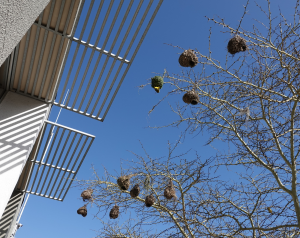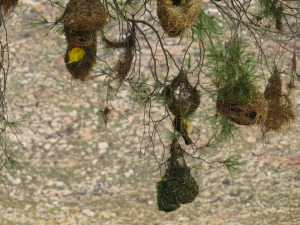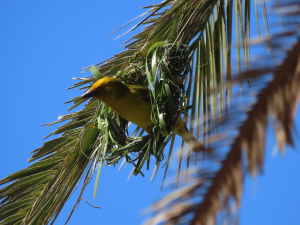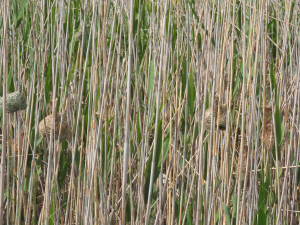Weaver species
Choose different species from drop-down list and press 'Go' button. See Full species list.Cape Weaver Ploceus capensis
IUCN: Least concern Discovery: 006Categories: golden, , acacias, fruit, waterbirds, gum, Linnaeus, Gymnogene, nectar, pest, Nest use, double nests, blue eggs, palm,
News items about species
Discovery

figure by Martinet (in Daubenton 1783) 
the Cape Weaver in great detail, figure from wikipedia 
figure painted by Lady Anne Barnard 
type locality circled IntroductionAfter Linnaeus published his 10th edition of Systema Naturae, he came across many more species. His 12th edition (Linnaeus 1766) contains several more weavers, the first being the Cape Weaver. Linnaeus gave a very short description, based on the longer description in Brisson 1760.Mathurin Jacques Brisson, a French zoologist, wrote his book on birds in several volumes, each page having 2 columns (one in French and one in Latin). Brisson gave the names "Le Carouge du Cap de Bonne Esperance" (French, for Oriole of the the Cape of Good Hope) and Xanthornus Capitis Bonae Spei (Latin). Many of Brisson's Latin names for birds were given before Linnaeus, but they were not constructed as binomial names, and thus do not qualify as scientific names. Brisson noted that the Cape Weaver originated from the Cape of Good Hope. This could be from anywhere in the Cape but most likely the Cape Weaver was taken from the Cape Peninsula. Brisson found the Cape Weaver specimen in the bird collection of Abbe Octave Aubry, a French parish priest who was rector of Saint-Louis. The Cape Weaver was first illustrated by Francois-Nicolas Martinet, under the supervision of Edme-Louis Daubenton, a French naturalist, in 1783. Martinet engraved and painted over 1000 colour plates for the Histoire naturelle (1749-89), providing the largest collection of bird paintings in the world at the time. Troupiale olive de Cayenne The earliest written record referring to an African weaver that is identifiable, is a record of a Cape Weaver from 1630. Friar Francisco dos Santos was a Portuguese priest on the ship San Gonzales which became stranded in Formosa Bay (=Plettenberg Bay, South Africa) in June 1630. While stranded on land for 9 months, Santos wrote about the fauna and flora, the earliest record for the region. He described hanging weaver nests and the only known Ploceus weaver in Plet at that time was the Cape Weaver. Read the fascinating story here. Two other interesting early records are paintings of weaver nests by Lady Anne Barnard from 1797 in Stellenbosch (PHOWN 4953) and 1798 a farm dam near Porterville (PHOWN 4954). Again, these can only belong to the Cape Weaver, since the Southern Masked Weaver did not occur in the Western Cape before 1900. Interestingly, the Cape Weaver does not appear to be common in Stellenbosch today, although it is very common in the surrounding farmlands. Scientific citationOriolus capensis Linnaeus 1766 Syst. Nat. 12th ed. I, p.163 Cape of Good HopeMeaning of namescapensis After the Cape of Good Hope (Modern Latin: Caput Bonae Spei; Portuguese: Cabo de Boa Esperanca), South Africa.First English nameOlive Oriole (Latham 1782)Alternate namesOlive Weaver, Cape Golden Weaver, Eastern Cape Weaver Bird, Golden-crowned Weaver bird, Yellow green Weaver-BirdCollectorUnknown.Date collectedBefore 1760, when the Cape Weaver was first described.Locality collectedCap. b. spei = Cape of Good Hope (probably the Cape Peninsula)Type specimensNo type specimens known to survive, but the painting of Martinet may serve as a type, although it may or may not be the same individual specimen as described by Brisson. |
The above is based on Weaver Wednesday 2, a weekly series about the discovery of each weaver species.
This species text first appeared as
Weaver Wednesday [123] - Discovery [6]: Cape Weaver on 2014-10-22
1. Basic biology



Identification. The Cape Weaver Ploceus capensis is a large weaver, with a long bill. The adult male (above left) in breeding plumage is bright yellow with varying amounts of orange-brown on the face, a black bill, and a pale eye. The female (above middle) is olive, with a yellow throat and belly, brown eye, and pale horn bill. Adult females usually have brown eyes, but 19% have pale eyes in summer and thus eye colour alone cannot be used to sex this species (read more at here). The male is in non-breeding plumage for a relatively short time when it resembles the female but is yellower below, and retains the pale eye. The juvenile (above right) is dull, with a yellowish belly.
Distribution. No subspecies of the Cape Weaver are recognised and it is a near endemic to South Africa (see map left, based on The Atlas of Southern African Birds and on SABAP2). The stronghold of the species is in the Western Cape. Currently it seems to have decreased its range in some areas, particularly in the northern Free State and North-West Province (red grids on the map). Habitat. The Cape Weaver inhabits open country with some trees and permanent water. In hot, drier regions it is restricted to montane areas. The Cape Weaver never occurs in forest. This species is found in flocks, and it forms large roosts throughout the year, which may be shared with other weavers and species. In some areas they leave their breeding sites, and do not return until the following season. Anting has been recorded. Cape Weavers may bathe even in misty or rainy conditions. Food. The Cape Weaver has a relatively long bill that is adapted to feeding on a wide variety of vegetable and animal matter. There is a long list of recorded food items, including various insects, spiders, seeds, nectar, and fruit. Females appear to have a more varied diet than males. They forage on the ground and may turn over small stones and dried cow-pats. They also search the bark of trees for insects, and hawk flying insects. Cape Weavers are generalist nectar-feeders that are now considered to be the major pollinators of aloes. Breeding. The Cape Weaver is colonial and highly polygynous with up to 7 females per male. Males are strongly territorial within a colony, and males chase intruders off neighbouring territories. The nest (photo left from phown 1094) is built by the male. The nest is a bulky, kidney-shaped structure, with the entrance below and usually without an entrance tunnel. Males display from their nests to attract females. If a female accepts a nest, she lines it with fine grass. Cape Weaver nests are mostly built in a variety of trees (n=725, PHOWN database), often exotics like gum, poplars, and willow trees, but also in indigenous trees like acacias. Nests are also built in reeds (n=140) and on man-made sites (n=9). Colonies may be large with up to 348 nests recorded, but the average colony size is around 20 nests. Some interesting PHOWN records are: boomslang raiding colony phown 572 (photo right), colony in shopping mall phown 1260, and nests built on a building phown 1196. Cape Weavers also build their nests near nests of larger birds, like Hadedas or in heronries. Old nests may be used by Cape Sparrows Passer melanurus or African Dusky Flycatchers Muscicapa adusta. |
The above is based on Weaver Wednesday, a weekly series about weaver species.
This species text first appeared as
Weaver Wednesday [32]: Cape Weaver on 2013-01-23
2. Breeding facts
| Pair bond Polygynous, with up to seven females per male Breeding season Jul-Nov in winter-rainfall region of Western Cape (even Jun when high rainfall occurs early in season) and Aug-Feb (sometimes to Apr) in summer-rainfall region Nest site supported on each side by reeds or bulrushes (Typha), or suspended from tip of branch, occasionally on fence or telephone line; placed low in reeds, often less than 1 m above water, but in trees up to 10 m above ground Nest building woven by male, lined by female Colony size Highly territorial Clutch size 2-5 eggs (mean 2.6 in Western Cape) Egg colour plain deep tuquoise-blue Egg size average size of 23 eggs 25 x 16.6 mm (South Africa) Incubation incubation by female, period 13-14 days Chicks and nestling period chicks fed by female, late in season sometimes also by male, and some males contribute as much as does female |
Breeding information based on Handbook of the Birds of the World, Vol. 15.
3. Photos of Weaver Nests
 Vm 31397 |  Vm 31117 |  Vm 31116 |  Vm 31094 |  Vm 31029 |  Vm 30915 |
Thumb-nails of most recent PHOWN records - click on one to see its full record
See all PHOWN records for this species here.
PHOWN (Photos of Weaver Nests) provides valuable info on breeding distribution and colony sizes of weavers.
You can contribute by registering and submitting photos at Virtual Museum webpage.
4. Breeding distribution
Google map showing distribution (For species with small ranges you need to zoom in at the correct area to see the range):
yellow blob - range of weaver species; read more about this here.
![]() - PHOWN records with photos
- PHOWN records with photos
![]() - PHOWN records with no photos (Nest Record Cards, other records)
- PHOWN records with no photos (Nest Record Cards, other records)
![]() - Birdpix records
- Birdpix records
![]() - comments on out of range records, or interesting records
- comments on out of range records, or interesting records
![]() - type locality
- type locality
CLICK on the marker on the map to see individual record details.
5. Range changes

Red, orange and yellow = cells with very large, large, and small relative decreases Blue, dark green and light green = cells with very large, large and small relative increases. Cells = quarter-degree grid cells; Only cells with at least 4 checklists in both SABAP1&2 shown. All cells had this species recorded in SABAP1 or in SABAP2 or in both (more about interpretation at Biodiversity Observations 7.62: 1-13).
Range changes in SA
The points below match the points on the map above. Areas with very large increases include:
Areas with mixed changes:
Areas with very large decreases:
Range changes elsewhereNamibia: breeding records on the Namibian side of the Orange River (Oschadleus 2016z3). | |||||||||||||||||||||||||||||||||||
The above is based on Weaver Wednesday 3, a weekly series about range changes in South African weaver species.
This species text first appeared as
Weaver Wednesday 3 [247] - Range changes [10]: Cape Weaver on 2017-03-08














